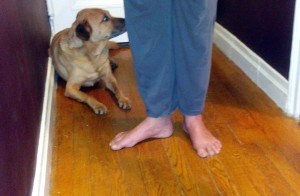 Movement patterns are developed, not inherited. We might have movement patterns that are similar if not identical to our parents and/or siblings but those patterns are likely imitative more than inherited. Yesterday I wrote about most babies standing up and walking without anything more than a cheer and “way to go” from their parents and these days it is the literal truth. In a different era schools taught anatomy and even deportment classes. Often mocked finishing schools that made girls walk around with blocks on their heads were doing them a service.
Movement patterns are developed, not inherited. We might have movement patterns that are similar if not identical to our parents and/or siblings but those patterns are likely imitative more than inherited. Yesterday I wrote about most babies standing up and walking without anything more than a cheer and “way to go” from their parents and these days it is the literal truth. In a different era schools taught anatomy and even deportment classes. Often mocked finishing schools that made girls walk around with blocks on their heads were doing them a service.
As I mentioned yesterday there are many factors that affect our movement patterns. One that is easily overlooked is the way we compensate for injury and then forget to stop compensating. It might seem silly but if I woke up tomorrow and decide that I wanted to walk with my foot turned out like it is in the picture above (A boy and his dog: that’s our incredibly sweet Ollie), my foot and hip might hurt after the first day or two but after a month I would be walking in pretty much the way the pictures shows.
This is what happens to one degree or another every time we get injured. If I break my pinky toe I will not want to put weight on the outside of my foot while it heals. This makes perfect sense in the short-term but what about when the pinky toes is healed? I realize that it requires a decent amount of conscious awareness but once the injury is better we have to realize the need to undo the compensation that we used to facilitate healing.
This is easier said than done as our brains are oddly designed to make us feel normal as we proceed through the world so there a number of factors affecting the way we process injury. I rarely find adults with wherewithal to understand concepts like this so how could we expect a seven-year old girl who breaks her ankle to make a similar leap.
Accommodating movement patterns to compensate for injury is a normal and healthy process. Developing the ability to understand and unwind compensations after healing is a subtle but beneficial skill. So many of the people I work with who suffer from chronic pain end up tracing the pain back to age-old injuries.
***
